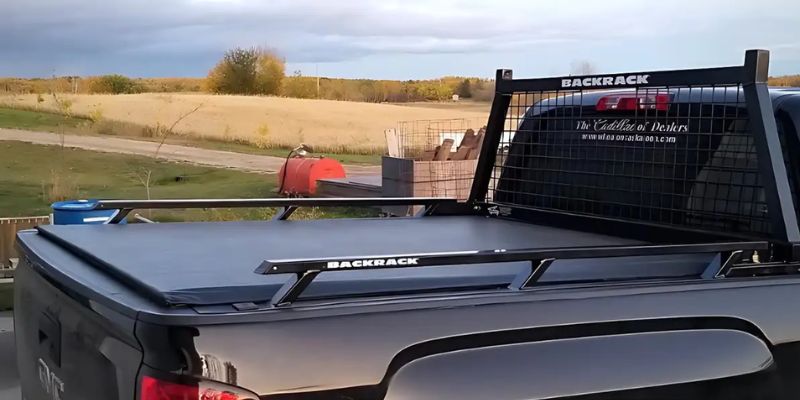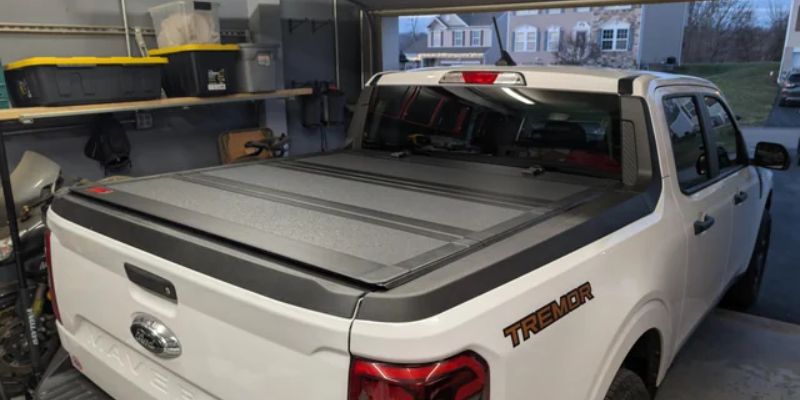Yes, you can install a tonneau cover on a truck with bed rails. However, the cover must be compatible with the existing rail system or require a special installation kit. Check the cover’s specifications or consult with the manufacturer to ensure a proper fit.
Understanding Bed Rails and Tonneau Covers

Defining Bed Rails and Their Purpose
Truck bed rails are metal or plastic bars that run along the upper edge of a truck’s bed.
Their primary purpose is to help secure cargo, providing tie-down points that ensure items are safely fastened during transport.
Additionally, bed rails can also serve an aesthetic function, adding a sleek or rugged look to a truck’s profile.
Exploring Tonneau Covers and Their Benefits
A tonneau cover is a protective shield that fits over the bed of a truck.
It safeguards the cargo from weather elements like rain, snow, and extreme sun.
It also offers security against theft and can improve a truck’s aerodynamics, potentially leading to better fuel efficiency.
Tonneau covers come in various styles and materials to suit different needs and preferences.
Compatibility Issues Between Bed Rails and Tonneau Covers
Although both bed rails and tonneau covers serve important functions, they can sometimes interfere with one another.
The main compatibility issue arises from the mounting system of tonneau covers, which often uses the same rails or space along the bed where bed rails would be installed.
This can create a challenge when trying to use both accessories simultaneously.
Considerations Before Combining Bed Rails with a Tonneau Cover
Before attempting to combine bed rails with a tonneau cover, one must consider the type of bed rail and tonneau cover design, the compatibility of their mounting systems, and the purpose of installing both.
It is essential to ensure that both accessories can be securely attached without hindering the functionality of either one.
Consulting with the manufacturer or a professional installer can provide guidance on the best course of action.
Installation Options for Tonneau Covers with Bed Rails

Types of Tonneau Covers Suitable for Trucks with Bed Rails
Soft Roll-Up Tonneau Covers
Soft roll-up tonneau covers are flexible and can easily work with existing bed rails, provided there is access to the inner lip of the truck’s bed for clamping.
These covers are typically lightweight and user-friendly, making them a popular choice for truck owners with bed rails.
Hard Folding Tonneau Covers
Hard folding tonneau covers offer more security and can sometimes be installed with bed rails.
However, it’s important to ensure that the folding mechanism does not interfere with the bed rails.
Some manufacturers offer compatible systems that work together seamlessly.
Retractable Tonneau Covers
Retractable tonneau covers provide a sleek design and are often compatible with bed rails.
They retract into a canister at the front of the bed, allowing for the use of bed rails without much hassle.
However, always check for compatibility with the rail system to avoid any functional conflicts.
Step-by-Step Guidance on Installing a Tonneau Cover with Existing Bed Rails
When installing a tonneau cover on a truck with existing bed rails, it’s crucial to follow a detailed process to ensure proper fit and function.
This involves measuring the bed and rails, aligning the cover with the rails, securing the cover’s clamps, and verifying that the cover operates smoothly without obstruction.
Adapting Bed Rails to Fit Tonneau Covers
Using Bed Rail Adapters
Bed rail adapters are designed to bridge the gap between bed rails and tonneau covers.
They allow for the installation of a tonneau cover without removing or altering the existing bed rails.
These adapters must be chosen based on the specific make and model of the truck and the type of bed rails and tonneau cover used.
Custom Modifications
In some instances, custom modifications may be necessary to fit a tonneau cover with bed rails.
This could involve cutting, drilling, or fabricating parts to create a compatible system.
This route should be taken with caution and ideally performed by professionals with experience in truck customization.
Professional Installation vs. DIY Approach
Deciding between professional installation and a do-it-yourself (DIY) approach depends on one’s comfort level with tools and vehicle modification.
While professional installation guarantees expertise and potentially warranty coverage, a DIY approach can be more cost-effective for those who are handy and have the necessary tools.
Maintenance and Care for Trucks with Bed Rails and Tonneau Covers

Routine Checks and Adjustments to Ensure Proper Fit
Regular inspections of both the tonneau cover and bed rails are critical to maintaining their functionality.
This includes checking for any loose components, ensuring clamps and locks are secure, and verifying that the cover is aligned correctly with the bed rails.
Adjustments should be made as needed to prevent any damage or wear.
Cleaning and Protecting Your Tonneau Cover and Bed Rails
Cleaning your tonneau cover and bed rails with appropriate cleaners can protect them from the elements and keep them looking new.
Using soft cloths, mild soap, and avoiding harsh chemicals will prevent damage to the materials.
Regular maintenance also includes checking for rust on metal components and applying protective coatings when necessary.
Weatherproofing and Sealing Considerations
Ensuring your tonneau cover and bed rails are properly sealed against the weather is crucial.
This includes checking the seals and gaskets for any cracks or wear and replacing them if needed.
Proper weatherproofing keeps the truck bed dry and protects cargo from moisture and debris.
Tips to Prolong the Life of Both Bed Rails and Tonneau Covers
To extend the lifespan of your bed rails and tonneau cover, regular maintenance is key.
This includes promptly addressing any issues, such as tears or dents, avoiding overloading the bed rails, and not exposing the tonneau cover to unnecessary stress or heavy snow accumulation.
Simple steps like these can significantly increase their longevity.
Troubleshooting Common Issues with Tonneau Covers on Trucks with Bed Rails
Issues such as difficulty closing the tonneau cover, water leakage, or noise while driving can arise when using bed rails with a tonneau cover.
Troubleshooting these problems might involve realigning the cover, adjusting tension, or replacing worn seals.
It’s important to address these issues promptly to prevent further complications.
FAQs About Installing a Tonneau Cover on a Truck with Bed Rails
Can you install any tonneau cover on a truck with existing bed rails?
Not all tonneau covers are compatible with every truck’s bed rails. It’s important to check the cover’s specifications or consult with the manufacturer to ensure a proper fit with your existing rail system.
Do you need a special installation kit to put a tonneau cover on a truck with bed rails?
Some tonneau covers may require a special installation kit to fit properly with bed rails. Verify this with the cover’s manufacturer or product details.
Will installing a tonneau cover affect the use of my truck’s existing bed rails?
Installation of a tonneau cover may affect the functionality of your truck’s bed rails depending on the design of the cover. Check compatibility before purchasing.
How can you ensure a tonneau cover will fit a truck with bed rails?
To ensure a proper fit, compare the tonneau cover’s specifications with your truck’s bed rail dimensions and consult with the cover’s manufacturer if necessary.
Are there tonneau covers specifically designed for trucks with bed rails?
Yes, there are tonneau covers made specifically to accommodate trucks with bed rails. Look for covers advertised as compatible with bed rail systems.
Final Thoughts
Installing a tonneau cover on a truck with bed rails is feasible, provided the cover is designed to work with the rail system.
It’s crucial to verify compatibility or obtain the necessary installation kit.
For assurance of a proper fit, checking the product details or consulting the manufacturer is recommended.
